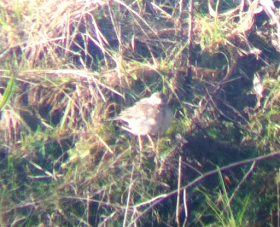When a Pacific Diver remarkably turned up on an inland pool in Northumberland last week, it was extremely tempting to make the long journey up north in an attempt to catch up with this American visitor. Despite having previously seen the returning Penzance bird in Cornwall on two separate occasions, this was a great chance to watch this mega diver species up close and an opportunity we simply couldn’t pass up! I’ve always maintained I would twitch an inland Pacific Diver should one ever occur again, and sure enough Saturday morning saw us travelling north up the M1 to Northumberland!
Arriving on site just after lunch and with the diver having relocated to Druridge Bay CP (after apparently attempting to fly back out to sea before doing a u-turn and crash landing on the ice), straight away we were afforded outstanding views as it made several circuits right in front of us around the north west corner of Ladyburn Lake.
With the Penzance Pacific Diver remaining mostly distant, this was a not-to-be-missed opportunity to really see the distinguishing features up close for ourselves and to try and get some photographs. Being present for 3 days before the ID was nailed as Pacific instead of the previously thought Black-throated Diver, the lack of a pale white flank patch was the giveaway to its true identity, while the black, albeit faint chinstrap visible at closer range sealed the deal.
Enjoying amazing views of the diver for a good hour and a half as it swam and dived right in front of us, it seemed totally unfazed by its squad of paparazzi admirers, at several points surfacing mere metres away from the crowd! It’s not every day you get to see a diver show so well, let alone a 6th for Britain Pacific Diver!
With the Penzance Pacific Diver remaining mostly distant, this was a not-to-be-missed opportunity to really see the distinguishing features up close for ourselves and to try and get some photographs. Being present for 3 days before the ID was nailed as Pacific instead of the previously thought Black-throated Diver, the lack of a pale white flank patch was the giveaway to its true identity, while the black, albeit faint chinstrap visible at closer range sealed the deal.
Enjoying amazing views of the diver for a good hour and a half as it swam and dived right in front of us, it seemed totally unfazed by its squad of paparazzi admirers, at several points surfacing mere metres away from the crowd! It’s not every day you get to see a diver show so well, let alone a 6th for Britain Pacific Diver!
We also noticed that the Pacific Diver also tended to leap out of the water quite considerably when diving compared to other species of diver, again, another subtle difference from the Black-throated.
 |
| Ladyburn Lake - the Pacific Diver often came to within feet! |
Alex's great video of the Pacific Diver in action!
Never the less, this was an incredible experience to get so close to a remarkable bird, and even my car breaking down mid-route northbound up the A1 wasn’t going to stop us seeing it!


































